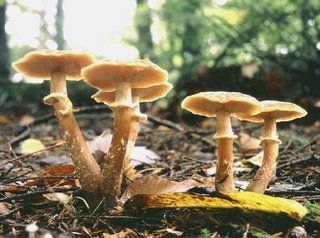What's the largest living thing in the world?
Did you say the blue whale? Good guess but no cigar. After all, the average blue whale measures about 75-80 feet long (23-24.5 meters) and weighs about 110 tons (99,800 kilograms). The blue whale is the largest living animal on earth. But there is another living thing that's bigger. Much, much bigger. It stretches 3.5 miles (5.6 kilometers) across and covers an area larger than 1,600 football fields. Most of it is hidden underground.
It's..... a fungus. Yes, a fungus with the scientific name Armillaria ostoyae. Known more commonly as the honey mushroom, this giant fungus was found in the Malheur National Forest in eastern Oregon.

Fungi straddle the realms of microbiology and macrobiology. Some fungi, such as the yeast used in baking bread and the fungus that causes athlete's foot, are microscopic. Other fungal species can grow into very large, multicellular mats or form the large, visible structures we commonly call mushrooms. The enormous Armillaria, which kills tall trees by infecting their roots, is related to the microscopic mycorrhizae symbiotic fungi that live on the roots of most plants help them absorb nutrients?
The bulk of the Armillaria fungus is made up of what's called the mycelium. The mycelium is a tangled mass of long strings of cell-like units joined together. These strings are called hyphae. The cells in fungal hyphae are similar to, but not quite like the cells that make up our bodies. The hyphae cells contain nuclei, like ours. But unlike our cells, the hyphae cells usually are not completely walled off from each other. They may be separated by a cross-walls called septa, but usually the septa have holes in them allowing the cell fluid, or cytoplasm, of neighboring cells to mingle. In some fungal species the hyphae contain no septa; they appear as long, continuous cells with multiple nuclei.
Most of the visible part of Armillaria is its golden mushrooms. Mushrooms are big masses of hyphae. They are reproductive structures. They contain spores, which are like seeds. When released, they germinate and produce hyphae.
It's..... a fungus. Yes, a fungus with the scientific name Armillaria ostoyae

Fungi straddle the realms of microbiology and macrobiology. Some fungi, such as the yeast used in baking bread and the fungus that causes athlete's foot, are microscopic. Other fungal species can grow into very large, multicellular mats or form the large, visible structures we commonly call mushrooms. The enormous Armillaria, which kills tall trees by infecting their roots, is related to the microscopic mycorrhizae symbiotic fungi that live on the roots of most plants help them absorb nutrients?
The bulk of the Armillaria fungus is made up of what's called the mycelium. The mycelium is a tangled mass of long strings of cell-like units joined together. These strings are called hyphae. The cells in fungal hyphae are similar to, but not quite like the cells that make up our bodies. The hyphae cells contain nuclei, like ours. But unlike our cells, the hyphae cells usually are not completely walled off from each other. They may be separated by a cross-walls called septa, but usually the septa have holes in them allowing the cell fluid, or cytoplasm, of neighboring cells to mingle. In some fungal species the hyphae contain no septa; they appear as long, continuous cells with multiple nuclei.
Most of the visible part of Armillaria is its golden mushrooms. Mushrooms are big masses of hyphae. They are reproductive structures. They contain spores, which are like seeds. When released, they germinate and produce hyphae.

1 Comments:
With a fungus that large....there isn't mushroom for anything else.
Post a Comment
<< Home